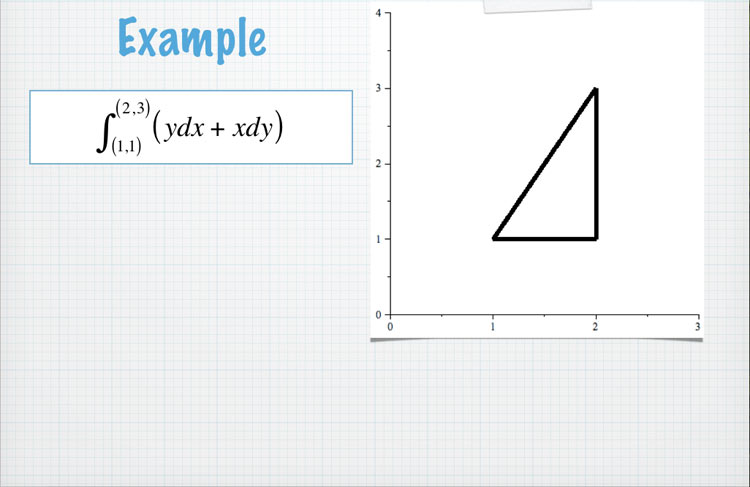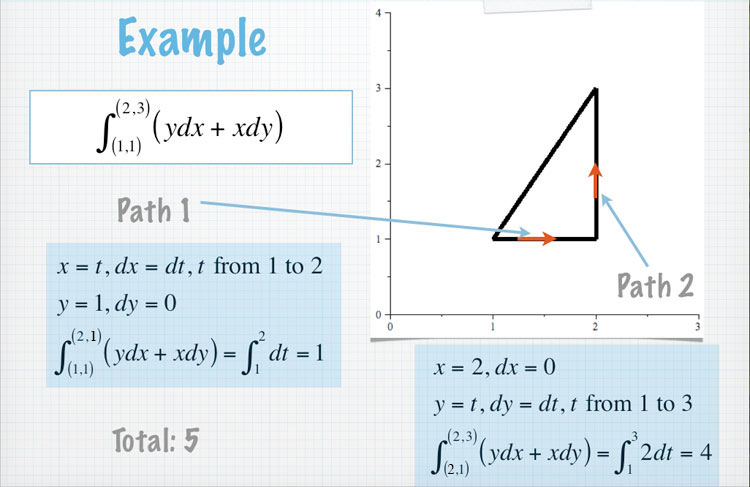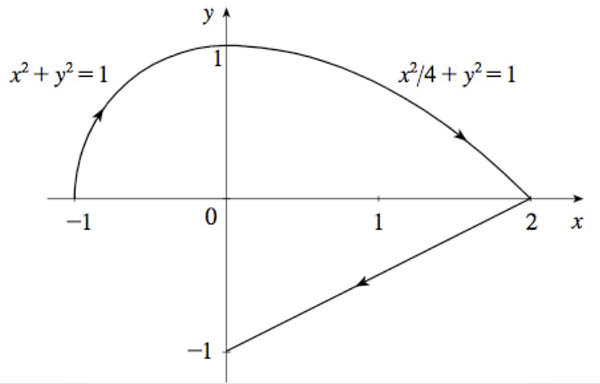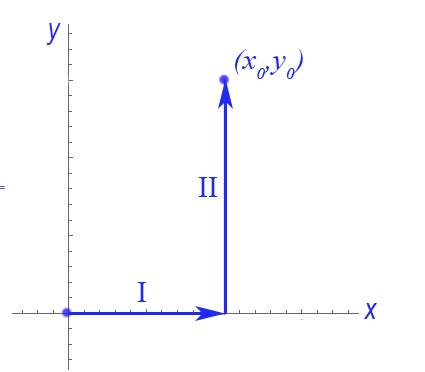Fundamental Theorem: Vector Line Integrals

Fundament = Foundation
Path independence
 In general, the value of a line integral of a given vector function depends, not only on the endpoints, but also on which path is taken.
In general, the value of a line integral of a given vector function depends, not only on the endpoints, but also on which path is taken.
A line integral is independent of path if it has the same value on ALL paths between $P_1$ and $P_2$. For the integrals above, we found: $$\color{blue}{\int_\text{blue}\myv F\cdot \myv r=0},$$ $$\color{red}{\int_\text{red}\myv F\cdot \myv r=-\frac 23 },$$ $$\color{green}{\int_\text{green}\myv F\cdot \myv r=0}.$$
These line integrals are apparently not independent of the path.
Fundamental Theorem - single variable
The fundamental theorem of calculus for a single variable: $$\int_a^b \frac{df(x)}{dx}\,dx=\left.f(x)\right|^{x=b}_a=f(b)-f(a)$$ where $\frac{df(x)}{dx}$ is continuous on $[a,b]$.
All the fundamental theorems that we shall see relate the integral of some kind of derivative of a function over some kind of interval to the values of the function at the boundary of the interval.
Conservative fields - revisited
The gradient of a potential function, $\myv F(x,y,z)=\myv \grad f(x,y,z)=\langle \frac{\del f}{\del x}, \frac{\del f}{\del y}, \frac{\del f}{\del z}\rangle$ is a conservative vector field.
Integrate it?? $$\begineq \int_C\myv F\cdot d\myv r &=& \int_C(\myv\grad f)\cdot d\myv r = \int_{t=a}^b (\myv\grad f(\myv r(t))\cdot \myv r'(t)\,dt \\ &=&\int_{t=a}^b \langle \frac{\del f}{\del x}, \frac{\del f}{\del y}, \frac{\del f}{\del z}\rangle \cdot \langle \frac{dx}{dt}, \frac{dy}{dt}, \frac{dz}{dt}\rangle \rangle \,dt \\ &=&\int_{t=a}^b \left( \frac{\del f}{\del x}\frac{dx}{dt}+\frac{\del f}{\del y}\frac{dy}{dt}+ \frac{\del f}{\del z}\frac{dz}{dt} \right)\,dt \endeq $$
But we recognize $(...)$ as $df/dt$ expanded with the chain rule, so we conclude that: $$\int_C\myv F\cdot d\myv r =\int_{t=a}^b \frac{d}{dt}f(t)\,dt=\left.f(t)\right|_a^b=f(\myv r(b))-f(\myv r(a)).$$
This is $\Delta f$, the change in "height" of the potential function between $\myv r(b)$ and $\myv r(a)$.
The integral only depends on the locations of the points at the beginning and end of the path.
At no point in what we just calculated did any details of the path $C$ come into play. So apparently...
The line integral of this conservative field, $\myv F$ is path independent.
In physics, the potential function often corresponds to a potential energy: Gravitational, electric potentials.
A potential function is like "landscape". When a body moves in a conservative field, after a round trip, the body will return to the same position in the landscape, and thus it will have the same height (potential energy) as it started with.
In terms of the vector function $\myv F$...

A round trip--same starting and ending point--along a particular path is denoted as $\oint_C$. So we could also write this as $$\oint_C\myv F\cdot d\myv r = 0$$ for all round trips $C$.

Checking a few paths
Let our potential function be... $$f(x,y)=xy$$
Then $f_x=y$ and $f_y=x$. So the vector function $$F=y\uv i +x\uv j$$ is conservative.
So, the integral... $$\int_C \myv F\cdot d\myv r=\int_{\myv r(a)}^{\myv r(b)}(y\,dx+x\,dy)$$ should be independent of the path $C$ taken.



Detecting a conservative field
For a continuous function, $f(x,y)$, recall that... $$\begineq f_{yx}&=&f_{xy}\\ \frac{\partial}{\partial y}\frac{\partial f}{\partial x} &=& \frac{\partial}{\partial x}\frac{\partial f}{\partial y} \endeq $$
Writing $\myv F=\frac{\partial f}{\partial x} \uv i + \frac{\partial f}{\partial y} \uv j=P\uv i+Q\uv j$, we see that this implies that... $$ \frac{\partial}{\partial y}P = \frac{\partial}{\partial x}Q $$ This is only true for conservative fields.
Saved by a conservative field
Integrate the vector function
$$\myv F = 2xy\uv i +x^2\uv j$$
along this fearsome-looking path:

Could this $\myv F$ be the gradient of some function $f$? Applying our test$ \frac{\partial}{\partial y}P \stackrel{?}{=} \frac{\partial}{\partial x}Q$... $$ \frac{\partial}{\partial y}2xy=2x \ \ \ \frac{\partial}{\partial x}x^2=2x;$$
Yes -- it's conservative! This opens up two simpler possibilities to evaluate the integral:
- Guess the potential--After a little thought $f=x^2y$ should do the trick--and then just find the difference between the values of the potential at the end and beginning points: $$\int \myv F\cdot d\myv r=f(0,-1)-f(-1,0)=(0)^2(-1)-(-1)^2(0)=0.$$
- Even if you can't guess the potential, you could still choose some *more convenient* path connecting the beginning and end points to integrate along, such as the straight line connecting $(-1,0)\to (0,-1)$.
Visually
 Can you take advantage of path independence when integrating
along one of these paths from $a$ to $b$?
Can you take advantage of path independence when integrating
along one of these paths from $a$ to $b$?
To Do
- Think before you compute
Summary: path independence
For the vector field $\myv F=P\uv i+ Q\uv j$, the following statements are all equivalent and imply each other...
- Path independence $$\oint_{\text{all } C} \myv F=0$$
- The vector field is conservative.
- The vector field is irrotational. $$\myv \grad \times \myv F = 0$$
- Cross derivatives equal $$ \frac{\partial}{\partial y}P = \frac{\partial}{\partial x}Q $$
- The vector field is the gradient of some potential function $f$, $$\myv F=\myv \grad f.$$
Recipe to find the potential $f$ from a conservative $\myv F$
(Lab 09, #11)
How to find the potential, $f$, instead of just guessing?
$\myv F=\myv \grad f$ implies that for any path connecting the origin with a point $(x,y)$ this integral will evaluate to $$\int_{(0,0)}^{(x,y)} \myv F\cdot d\myv r=\int \myv \grad f\cdot d\myv r= f(x,y)-f(0,0).$$ along *any* path. So, by integrating we'll find $f(x,y)$ to within a constant. But any constant can be added to $f$ and we'll still get the same $\myv F$ after taking the gradient.
Example
Consider the function $\myv F(x,y)= (\sin (x y)+x y \cos (x y))\uv i+ x^2 \cos (x y)\uv j$. Is it conservative?

Yes!
 Integrate $\myv F$ along this path from the origin to $(x_0,y_0)$.
Integrate $\myv F$ along this path from the origin to $(x_0,y_0)$.
(We're using $x_0$ and $y_0$ instead of $x$ and $y$ so as not to mix up the arguments of the functions being integrated and the integration limits. We'll go back and replace them at the end.)
Along path I: $y=0$ and d$\myv r = dx \uv i$ so $$\myv F \cdot d\myv r =\left.F_x\right|^{y=0}\,dx=(\sin(x\cdot 0)+x\cdot 0 \cos(x\cdot y))dx = 0$$ So the integral is $$\int_I\myv F \cdot d\myv r =\int_0^{x_0}0\,dx = 0.$$
Along path II: $x=x_0$ and d$\myv r = dy \uv j$ so $$\myv F\cdot d\myv r =\left.F_y\right|^{x=x_0}\,dy= x_0^2\cos(x_0 y) \,dy$$ So the integral is $$\int_{II}\myv F\cdot d\myv r = \int_0^{y_0}x_0^2\cos(x_0 y) \,dy= \left.x_0\sin(x_0y)\right|_0^{y=y_0}=x_0\sin(x_0y_0).$$
Adding and substituting $x_0\to x$ and $y_0\to y$:
$$\int_I+\int_{II}=x\sin(xy)=f(x,y)-f(0,0).$$
And checking that the gradient of this function gives us our original vector function....

YUP!